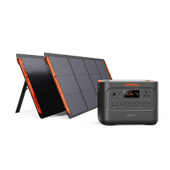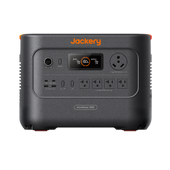Rolling Blackout: What is Rolling Blackout, How To Prepare and Prevent it?
Blackouts and power outages have been hitting some countries frequently, and America is no different. They happen due to natural calamities, like winter storms, heat waves, hurricanes, earthquakes, and tornadoes.
However, rolling blackouts are different — they are temporary or planned outages by grid regulators. They happen to bring back the supply-and-demand harmony and avoid severe power outages in the future.
But what exactly is a rolling blackout? And how long will the rolling blackout last? And, most importantly, how can you prepare for them?
Let's answer each of your questions in this article briefly.
What Is A Rolling Blackout?
First, let us understand — "what is a rolling power outage?"
In simple words — rolling blackouts are temporary power cuts planned by the grid operators. It can happen in any country and is mainly to get a power supply balance in a specific region.
Unlike unpredictable power outages, rolling blackouts are to avoid overloading the power grid during high demand. Different parts of the city receive temporary power outages for a specific time but not an extended period.
Although grid regulators warn customers about rolling blackouts in advance, sometimes they come with little to no warning. Planning ahead is the only thing you can do to deal with rolling power outages.

Image source: www.unsplash.com
Why Are They Doing Rolling Blackouts?
Several factors can be the reason for temporary power cuts in an area. The most common factor of blackout is power supply and demand fluctuations during peak hours.
As the power needs of an area rise, the power plant or electricity grids experience problems. As a result, grid regulators declare power outages when the power supply no longer meets demands.
Declaring rolling blackouts help residents to avoid extended power outages.
Another common reason for a power outage is the age of the power grid. When the infrastructure becomes older, it becomes prone to failing. And finally, this leads to uninvited blackouts that can affect an area.
How Long Do Rolling Blackouts Last?
So, now that you know the reasons for rolling blackouts, you might be wondering — how long do rolling blackouts last? However, there is no definite answer, as the duration depends on the event's severity. Usually, the rolling power outage will conclude in 1-2 hours, and the electricity will be restored.
In some severe events, it may take longer — 4-6 hours. These rollouts happen during the daytime when there is a high energy requirement, but power grids can no longer handle the load.
What Seasons Do Rolling Blackouts Happen Most?
You can expect a rolling blackout when there is a higher power demand than supply. Regardless of the season, temporary power outages can happen anytime, anywhere, and any place.
Winter blizzards, storms, or heat waves are a few reasons that put a strain on the power grid. As energy utilization spikes, the power grid companies turn to roll power cuts.
The same happened in 2021 when a severe winter storm attacked Texas. Due to the severity of storms, increased usage of heaters caused a spike in demand.
Regional power plants, wind turbines, and natural gas plants couldn't keep up with the energy demand. And ERCOT (Electric Reliability Council of Texas) had to announce a blackout in many parts of the state. In some areas of Texas, the power outage lasted for days, and consumers had to live without electricity.
Blackouts In The US
In May 2022, the North American Electric Reliability Corporation (NERC) warned that ⅔ of the US would experience blackouts. And the sequence of rolling blackouts is not going to end anytime soon.
The US has experienced bad droughts, contributing to rolling blackouts in different states and cities. As per the updates, the extreme weather is forcing the power grids across the US to impose rolling blackouts.
The officials are insisting people purchase power backup solutions for their homes and businesses. Let us understand the condition of Texas and California concerning power outages below.
1. Texas Rolling Blackout
Texas is known to impose frequent power outages and rolling blackouts in various parts. Residents of Texans are likely to experience rolling blackouts on days with high energy loads, such as Sunday, Monday, and Tuesday, which could last for an hour or more.
But why are they doing rolling blackouts in summer?

The Electric Reliability Council of Texas (ERCOT) forecasts that the power demand will reach 77,311 Megawatts for summer according to Reuters research. The officials revealed that the chances of rolling blackouts are higher if there is a high peak load.
Texas has to deal with power outages if there are extended drought conditions. Hot weather will increase the usage of air conditioning and power plant failure risk.
Both scenarios can contribute to extended and frequent rolling blackouts. Texas residents should implement energy efficiency measures to reduce their power bills and load on power grids to minimize blackouts.
2. California Rolling Blackout
The excessive heat waves across the state have forced the officials to impose the highest level of an energy emergency. The record-high temperature in September 2022 made the power grids vulnerable to threats.
The Office of Emergency Services in California has asked people to reduce their power consumption. California authorities imposed rolling blackouts as the peak power demand reached 52,061 megawatts.
The officials said that the risk of power outages is elevated due to high energy demand. They added that every resident needs to prevent and prepare for a rolling blackout in advance.
As the conditions are likely to persist for years, it's high time for residents to take measures and be self-reliant in terms of power.
California and Texas are prone to rolling blackouts due to the vulnerable power grid condition. Hence, consumers should switch to power backup solutions to prepare for unforeseen scenarios and avoid being powerless.
How To Prepare For A Rolling Blackout?
Texas and California have become notorious for rolling blackouts and power outages. But this isn't limited to particular countries, states, or cities.
With climate change, the likelihood of experiencing severe weather conditions increases. And the outcome is prolonged power outages or temporary blackouts.
No matter in which corner you live, you should be prepared for an unpredictable blackout. Electricity is the primary energy source that keeps your home warm during winter and cools during summer.
For many people, electricity is the only way to power their medical devices. But, a temporary power outage can leave all of us overwhelmed. The longer the power cut lasts, the more serious it could impact everyone in the area.
Here are a few ways to prepare your home for a temporary power outage that lasts for hours, days, or weeks.

1. Prepare a Power Backup Supply
As you see, power outages can hit any area and can last for days. Therefore, homeowners need to invest in a reliable power backup supply source.
One of the excellent power solutions is Jackery Solar Generator which comes with different charging capacities. The most feature-filled portable power stations — Jackery Solar Generator 2000 Pro— are perfect for charging home appliances.
Not to mention, the wireless and compact design of the generator makes it portable enough to carry around your home.
2. Stock Up Essential Supplies
A blackout for one or two hours may not require stocking supplies. But if it lasts longer for days, pharmacies and grocery stores in your area may not be able to cope with the essential demand.
In such a scenario, stocking up on all the essential supplies in advance is the best solution. Get some non-perishable foods that won't spoil without refrigeration. In addition, get all the medicines from the pharmacy in advance.
Some other supplies to stock in advance include warm clothes, flashlights, batteries, portable radios, etc. This will help you remain safe and comfortable during such events.
3. Stay Updated With ERCOT News
In most cases, ERCOT announces the temporary power outage in advance. Understanding when the rollout will happen can help you keep all the supplies ready to handle the electricity shutdown.
So, your first step is to sign up for blackout alerts from your power grid company. You can monitor the local news stations if the utility company does not provide alerts.
Many people rely on life-saving medical devices that work on electricity. If that's the case, inform your utility company about the same.
In addition, keep your car gas tank half full during such situations. This will help you evacuate the space if the condition becomes worse.
If you want to read more information, check out our guide on what to do when the power goes out.
How To Prevent Rolling Blackouts?
Rolling blackouts happen where there is high electricity demand and low supply. This is the by-product of extreme weather conditions, such as winter storms or heat waves, that increase electricity consumption.
One way to prevent rolling blackouts is to lower your electricity usage. Below is the list of a few ways to decrease the power consumption of your home.
- Off the lights and unplug all the large electrical appliances when you are not using them. Instead, practice switching them as soon as possible to reduce workload.
- Seal your room windows and doors to keep your family warm and comfortable.
- Electricity usage is at its peak during 3-7 PM. So, avoid using large appliances during these times.
- Raise the thermostat temperature by 2 or 3 degrees, especially during peak hours.
- Set your ceiling fan to turn counter-clockwise and produce a cooling effect in the room.
- Use the large appliances during the off-peak hours and perform your energy-demanding tasks.
- Perform cooking with small appliances like a slow cooker, oven, or toaster.
- Improve the home's energy efficiency by replacing traditional bulbs with LEDs.
- Use dynamic glass instead of windows to minimize air loss.
- Install solar panels to become self-reliant or less reliant on the power grid.
Following a few tips can help reduce the energy needs of your home. As a result, this will reduce the chances of rolling blackouts in your area.
Conclusion
Rolling blackouts or temporary power outages are a reality in cities with limited power supply and high demand. However, a few steps can help you prepare and prevent such things from happening. Make sure you are prepared for future power outages with the necessary essentials, such as a portable power supply source.
Jackery Solar Generator 2000 Pro is an excellent choice to meet the power supply of small and large electrical appliances. It features a 4400 watt peak surge power with a 2200Wh lithium battery capacity.
Don't wait for a rolling blackout to reach; get yourself a power supply source and make your home blackout-free. Subscribe to our newsletter to receive how-to user guides, the latest news, and exclusive deals.
Disclaimer:
The runtime mentioned for appliances powered by Jackery is for reference only. Actual runtime may vary under different conditions. Please refer to real-world performance for accurate results.














































































































Leave a comment